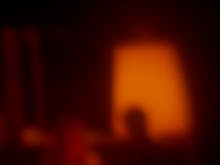1. The Mortal Lethahedron:
The drawn Lethahedron should be represented in public, and on as large a scale as possible, by perishable materials so that its impermanence is more apparent. Those observing it are welcome to participate in its destruction.
Special care must be taken with the environment in which it is created. since it is ideally a positive symbol and the most important aspect of it is the manner in which it is destroyed. Its destruction, then, must be a positive act.
At 4AM on the morning of October 3rd, 2008 I attempted such a large scale drawing with dirt on the campus of my school. It was almost entirely unsuccessful, due to the difficulty of the process of drawing with large amounts of dirt, the surprisingly large amount of dirt that was required, a lack of preparation for the amount of dirt required and, finally, an unsatisfactory amount of dirt due to time constraints (people in Brooklyn start walking their dogs at 5 am, and I felt especially conspicuous). The ultimate failure, detailed later, was that it could not be easily documented.
2. The Digital Lethahedron
It should be assumed that that the Lethahedron's effect is as tangible as any other ritualistic act. Its power, dependent on it being witnessed by a large number of people, is limited due to its fleeting physical existence. Its range is extended, however, if it is documented and perpetuated, something which has never been easier due to the prevalence of the camera in the life of the individual and the indefinte reach of the internet and its memes. As there are guidelines for its creation, so too are there for its documentation. Since the primary focus of the symbol, again, is its destruction, the focus of any documentation should be this act rather than the symbol itself.
On October 9th, 2008, I created a Wikipedia entry for the Lethahedron, meaning to begin this aspect of its manifestation. The name, meant to be unique so that it could be easily tracked, was chosen since it recieved no hits from a Google search. Wikipedia, however, found fault with this and, informing me that I had five days to improve the article, deleted it after four, describing it as "Patent Nonsense."




No comments:
Post a Comment